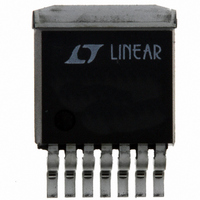LT1374CR-5 Linear Technology, LT1374CR-5 Datasheet - Page 20

LT1374CR-5
Manufacturer Part Number
LT1374CR-5
Description
IC SW REG 4.5A 5V STEP-DWN 7-DD
Manufacturer
Linear Technology
Type
Step-Down (Buck)r
Datasheet
1.LT1374CFEPBF.pdf
(32 pages)
Specifications of LT1374CR-5
Internal Switch(s)
Yes
Synchronous Rectifier
No
Number Of Outputs
1
Voltage - Output
5V
Current - Output
4.5A
Frequency - Switching
500kHz
Voltage - Input
5 ~ 25 V
Operating Temperature
0°C ~ 125°C
Mounting Type
Surface Mount
Package / Case
D²Pak, TO-263 (7 leads + tab)
Lead Free Status / RoHS Status
Contains lead / RoHS non-compliant
Power - Output
-
Available stocks
Company
Part Number
Manufacturer
Quantity
Price
Company:
Part Number:
LT1374CR-5
Manufacturer:
Linear Technology
Quantity:
135
Company:
Part Number:
LT1374CR-5
Manufacturer:
DSP
Quantity:
2 000
Company:
Part Number:
LT1374CR-5#PBF
Manufacturer:
LT
Quantity:
1 900
Part Number:
LT1374CR-5#PBF
Manufacturer:
LINEAR/凌特
Quantity:
20 000
Company:
Part Number:
LT1374CR-5#TRPBF
Manufacturer:
LT
Quantity:
1 900
Company:
Part Number:
LT1374CR-5.0
Manufacturer:
LT
Quantity:
1
LT1374
APPLICATIONS
The term inside the radical has a maximum value of 0.5
when input voltage is twice output, and stays near 0.5 for
a relatively wide range of input voltages. It is common
practice therefore to simply use the worst-case value and
assume that RMS ripple current is one half of load current.
At maximum output current of 4.5A for the LT1374, the
input bypass capacitor should be rated at 2.25A ripple
current. Note however, that there are many secondary
considerations in choosing the final ripple current rating.
These include ambient temperature, average versus peak
load current, equipment operating schedule, and required
product lifetime. For more details, see Application Notes
19 and 46, and Design Note 95.
Input Capacitor Type
Some caution must be used when selecting the type of
capacitor used at the input to regulators. Aluminum
electrolytics are lowest cost, but are physically large to
achieve adequate ripple current rating, and size con-
straints (especially height), may preclude their use.
Ceramic capacitors are now available in larger values, and
their high ripple current and voltage rating make them
ideal for input bypassing. Cost is fairly high and footprint
may also be somewhat large. Solid tantalum capacitors
would be a good choice, except that they have a history of
occasional spectacular failures when they are subjected to
large current surges during power-up. The capacitors can
short and then burn with a brilliant white light and lots of
nasty smoke. This phenomenon occurs in only a small
percentage of units, but it has led some OEM companies
to forbid their use in high surge applications. The input
bypass capacitor of regulators can see these high surges
when a battery or high capacitance source is connected.
Several manufacturers have developed a line of solid
tantalum capacitors specially tested for surge capability
(AVX TPS series for instance, see Table 3), but even these
units may fail if the input voltage surge approaches the
maximum voltage rating of the capacitor. AVX recom-
mends derating capacitor voltage by 2:1 for high surge
applications. The highest voltage rating is 50V, so 25V
may be a practical upper limit when using solid tantalum
capacitors for input bypassing.
20
U
INFORMATION
U
W
U
Larger capacitors may be necessary when the input volt-
age is very close to the minimum specified on the data
sheet. Small voltage dips during switch on time are not
normally a problem, but at very low input voltage they may
cause erratic operation because the input voltage drops
below the minimum specification. Problems can also
occur if the input-to-output voltage differential is near
minimum. The amplitude of these dips is normally a
function of capacitor ESR and ESL because the capacitive
reactance is small compared to these terms. ESR tends to
be the dominate term and is inversely related to physical
capacitor size within a given capacitor type.
SYNCHRONIZING (Available as -SYNC Option)
The LT1374-SYNC has the SHDN pin replaced with a
SYNC pin, which is used to synchronize the internal
oscillator to an external signal. The SYNC input must pass
from a logic level low, through the maximum synchroni-
zation threshold with a duty cycle between 10% and 90%.
The input can be driven directly from a logic level output.
The synchronizing range is equal to initial operating fre-
quency up to 1MHz. This means that minimum practical
sync frequency is equal to the worst-case high self-
oscillating frequency (550kHz), not the typical operating
frequency of 500kHz. Caution should be used when syn-
chronizing above 700kHz because at higher sync frequen-
cies the amplitude of the internal slope compensation
used to prevent subharmonic switching is reduced. This
type of subharmonic switching only occurs at input volt-
ages less than twice output voltage. Higher inductor
values will tend to eliminate this problem. See Frequency
Compensation section for a discussion of an entirely
different cause of subharmonic switching before assum-
ing that the cause is insufficient slope compensation.
Application Note 19 has more details on the theory of slope
compensation.
At power-up, when V
Figure 2, Q2), the sync function is disabled. This allows the
frequency foldback to operate in the shorted output con-
dition. During normal operation, switching frequency is
controlled by the internal oscillator until the FB pin reaches
1.5V, after which the SYNC pin becomes operational. If no
synchronization is required, this pin should be connected
to ground.
C
is being clamped by the FB pin (see
1374fd













